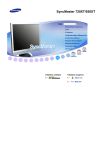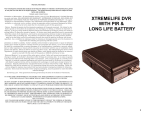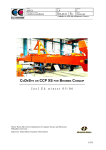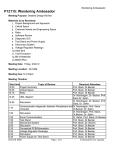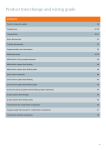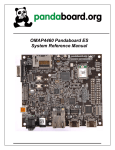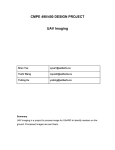Download Introduction 1. PandaBoard
Transcript
OSSConf 2012: 1–7 UTILIZATION OF OPEN HARDWARE PLATFORMS IN NETWORK APPLICATION AND EDUCATION MILAN FRÁTRIK Abstract. The aim of the article is to outline ARM architecture, its possible application and use of non-traditional technical means in network application, infrastructure and also to show the possible usage in learning process. The article can be divided into three parts. The first part introduces the PandaBoard platform as the representative of open hardware platform (OSHW1 ). The second part outlines the applications focusing on network application, mainly camera security and surveillance solution. The last part presents a vision of usage of open hardware platforms based on ARM architecture in learning process. Key words and phrases. ARM, PandaBoard, Zoneminder, security, Linux. Využitie open hardware platforiem v sieťových aplikáciach a vzdelávaní Abstrakt. Cieľom tohto článku je priblížiť architektúru ARM a ukázať možné aplikácie a využitia netradičných technických prostriedkov v sieťových aplikáciách, či infrašturktúre a taktiež načrtnúť možnosti využitia v procese vzdelávania. Članok možno rozdeliť do troch častí. V prvej časti je predstavená platform PandaBoard, ako predstaviteľ Open-source hardware. V druhej časti sú načrtnuté aplikácie so zameraním na sieťové aplikácie, predovšetkým bezpečnosť. Posledná časť predstavuje víziu využitia open hardware platforiem na báze ARM v procese výučby. Kľúčové slová. ARM, PandaBoard, Zoneminder, bezpečnosť, Linux. Introduction The ARM architecture nowadays is not unfamiliar to most people, but many people have no idea that there is RISC processor, most probably ARM, in their cell phones or tablets. What makes the ARM architecture important is the fact, that in addition to low consumption it has fully satisfying power for many user applications. On the other hand, more often we meet with non-standard use of these processors e.g. server solutions [1]. Individual examples of usage will be demonstrated on development kit PandaBoard. 1. PandaBoard Similarly as in the other „animal“ boards, the basis of the development board is SoC (System on a Chip). In this case, it is TI OMAP 4430 processor with two 2 Konferencia OSSConf 2012 Cortex-A9 cores. Except for two main cores, it disposes with four Cortex-M3 cores, which serve for operating peripherals. The clock frequency of computing cores is 1 GHz. Total computing power can reach 2x2.5 DMIPS/MHz x 1GHz. There is also GPU Power VR SGX540 and DSP processor C64x on the chip. The 8 Gbit LP-DDR2 RAM is connected to processor using the POP (package on package) method. Memory card SD/MMC serves for primary storage data and deployment of operating system, while by a little change it is possible to get booting from USB medium – through 3 USB slots, one is in OTG mode. Graphic and audio output ensures HDMI and DVI output, respectively 3.5 mm jack I/O. In terms of connectivity, there is 10/100 Mbit Ethernet, WiFi 802.11 b/g/n. and Bluetooth in 2.1 + EDR. Since this is a development kit, there are various pinouts. One of them is determined as the interface for LCD touchscreen, the second one is 14 bit interface for camera and the third connector with 40 outputs, which serves for access to peripherals MCU such GPIO, USART, SPI, I2 C, etc. For the advanced users there is a standard JTAG connector using which it is possible to debug software directly on the chip. The block scheme of the system is shown in Figure 1. Figure 1. PandaBoard block diagram 2. Standard applications on non-standard platform As was in the introduction, this article would demonstrate mainly network applications. This means applications, which use connection to LAN network, internet. M. Frátrik: Utilization of OSHW 3 To run a full operating system, the memory management unit – MMU is needed. This unit provides the translation of virtual address into physical address, memory protection, bus arbitration and cache memory check. Open hardware goes hand in hand with open source software. The excellent example is the use of operating system Linux on this platform, specifically operating system Ubuntu 12.04 server edition. Most of the packages is available for normal desktop PC’s and servers. 2.1. Database and web server Perhaps the most common application on servers is HTTP server accompanied by a database server and support for script languages. The most common used solution is so called LAMP (software bundle). This package contains Apache – HTTP server, MySQL – database server and Php. Thanks to these components, PandaBoard is ready to use all the applications using HTTP server. In this case, if we do not want to use LAMP, we dispose with the software package designed for application development in Java programming language. It is based on the application server Tomcat with OpenJDK. OpenJDK presents an open source implementation of Java language. The article [3] is focused on measurement of response time and throughput of web server. The results show that this web server is fully sufficient for personal sites with lower number of visitors. Combination of Cortex-A9 core with web server has now the best ratio between processed request and consumed energy [2]. 2.2. Multimedia and storage Similarly to a server with standard architecture, PandaBoard can implement network protocol SMB using Samba software. This allows sharing of files and printers on the network. Current trend of storage files is based mainly on cloud solutions and virtual storage. There is also an open source solution – ownCloud, which has been installed on PandaBoard. It is a cloud server, where clients are available for all the platforms (Windows, Linux, Mac, Android). Another possibility is to use the device for streaming audio respectively video and to create home VoD server. 2.3. Security Perhaps the most interesting is usage for monitoring of selected areas. Very often are devices for monitoring areas expensive. Fortunately, there is an open source solution named ZoneMinder. Using this software PandaBoard can be used as the server. ZoneMinder disposes with a web interface, which is fully configurable. This way, it is possible to set all the cameras (support for multiple cameras) and the streaming directly from web interface (2a). Camera can be configured in various modes – monitor, modetect, nodetect, record. The software supports 4 Konferencia OSSConf 2012 CCTV, IP and USB webcams. Evidently from the names of the modes, the software can also detect motion. In addition to detection in wide areas, it is possible to select only certain part of area and to control the motion especially there (3a). In case, when the movement is detected, the system sends warning via email or sms message. The big advantage is the automatic recording of individual events, where the motion appeared. This way the user gets complex information about the area. (a) ZoneMinder console (b) ZoneMinder camera view Figure 2. Camera configuration and camera view (a) Zone definition (b) Defined zone settings Figure 3. Zones definition M. Frátrik: Utilization of OSHW 5 3. Open hardware in learning process The last possibility, which is to be presented in this article, is the usage of open hardware platforms in the learning process. Current platforms, such as Raspberry PI and other „animal“ boards are not expensive ($25 for Raspberry PI). Thanks to the open operating system and hardware, the students would quickly get to know more advanced options of operating system. The platform presents intermediate between higher programming languages (C#, Java) and the lowest (Assembler, C), e.g. the communication among the peripherals of the processor by using L3 cache memory. It is possible to create various interfaces for converters non-electric variables, or other non-standard applications (creation of network of sensors for monitoring of temperature and humidity of the building, control of electric energy consumption). This is because of direct control of the peripheral (GPIO, USART, SPI, I2 C) from the programming language and expansion header. In following two examples, are shown the possibilities for control GPIO using file read/write operations and register MCU access, which stores the BandGap Temperature Sensor value [4]. Figure 4. Flowchart for turn on/off attached LED These two examples present the basis for working with MCU – the first serves for demonstration of less suitable control GPIO and the second for direct mapping of registers to memory. With the second example it is possible to control any processor peripheral. 6 Konferencia OSSConf 2012 Figure 5. Flowchart for temperature measurement 4. Conclusion The aim of this article was to show non-traditional application of TI OMAP4430 processor in network applications. Such devices may serve as private web servers or cloud servers, because not all the users would provide their data to the third party. Devices working on „lightweight architecture“ may also replace personal computers in many offices. Sufficient power, low energy consumption and last but not least broad connectivity create good conditions for the masses. References [1] HP (2011): HP Shapes the Future of Extreme Low-energy Server Technology, [Press release], Retrieved from: http://www.hp.com/hpinfo/newsroom/press/2011/111101xa.html. [2] SVANFELDT-WINTER, O. – LAFOND, S. – LILIUS, J.: [1] Cost and Energy Reduction Evaluation for ARM Based Web Servers, Dependable, Autonomic and Secure Computing (DASC), 2011 IEEE Ninth International Conference on, 12.-14. December 2011, pp. 480– 487. [3] FRÁTRIK, M.: When ARM architecture meets internet applications, ICTIC 2012 : proceedings in information and communication technologies – international conference, Žilina, 19.–23. March 2012, pp. 18–20, ISBN 978-80-554-0513-1. [4] TEXAS INSTRUMENTS: OMAP4430 Multimedia Device, Technical Reference Manual, March 2011, 5483 p. [5] FISHER, R.:SDP4430 Software Development Platform, [User manual]. Retrieved from: http://pandaboard.org/sites/default/files/board_reference/pandaboard-a/ panda-a-manual.pdf. M. Frátrik: Utilization of OSHW 7 Contact address Ing. Milan Frátrik, Department of InfoComm Networks, Faculty of Management Science and Informatics, University of Žilina, Univerzitná 8215/1, 010 26 Žilina, Slovak Republic, E-mail address: [email protected] 8 Konferencia OSSConf 2012








